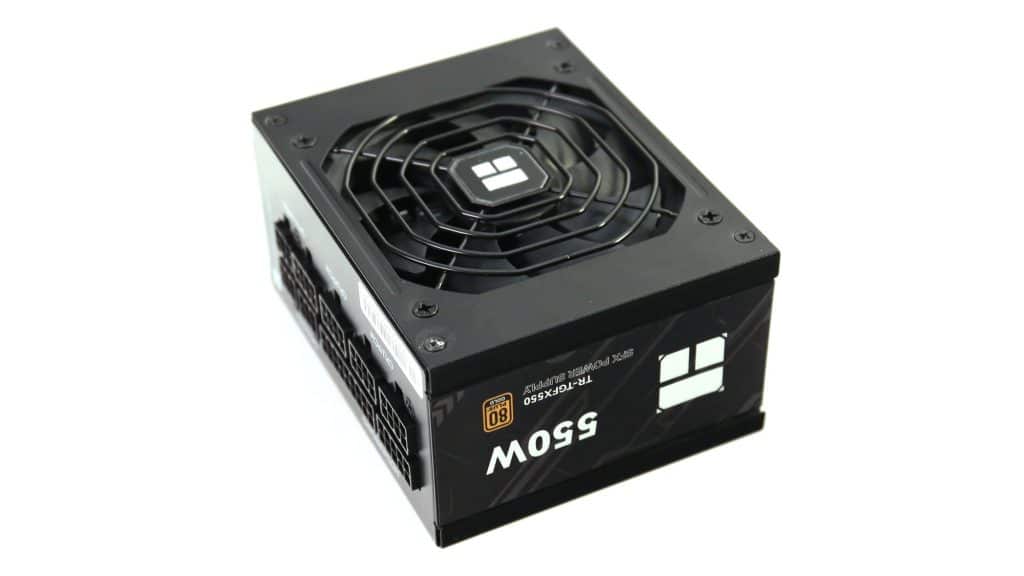Epilogue
Thermaright is well known for its budget products, and the TR-TGFX 550 follows this brand’s tradition. In China, it costs 500 RMB, which is about 69 dollars. You won’t find this PSU in any other market, and I am unsure if and when Thermalright will decide to sell it in other regions, too. This unit meets the ATX v3.1 requirements for units without the 12V-2×6 connector, with the peak transient load restricted to 150% instead of the 200% that applies to units with the connector mentioned above.
The build quality matches the unit’s price, and my main concern is the low-quality Yate Loon fan, which will probably start screaming after a while because of its double ball bearing. Usually, you don’t replace a DBB fan because it stopped spinning but because it makes a terrible bearing noise, and this is why you should avoid low-quality DBB fans. I am not a big fan of YL products. It would be better if Thermalright increased the production cost and used a higher-quality fan.
In terms of performance, the unit has a tight load regulation and a longer than 17ms hold-up time. Moreover, its efficiency is high, especially at light loads, and it easily meets the ATX v3.1 transient response requirements. On the other hand, ripple suppression is mediocre, the 12V rail’s deviation at the normal transient loads that I apply is high, vampire power is sky-high, and the power factor is low. In the protection features section, the over current and over power protection triggering points need adjustments. You cannot have the same OCP and OPP triggering point under cold and hot conditions! The unit gets stressed way more at high temperatures, so you should not allow for the same load levels as in cold temperatures.
In general, there are no shortcuts in PSUs. Thermalright enjoys increased popularity in the cooling solutions market because of its products’ high performance per price ratios. Still, many factors are equally important to performance in PSUs. I am not saying that this is not a decent unit, especially for its price, but it uses lower-quality parts, some crucial protection features need tuning, and ripple suppression is not good. Thermalright has to try way more to make the same impact in the PSU market as it achieved in the cooling market.
Before investing in a new power supply, read my Best ATX v3.x PSUs article to check all alternative PSU offerings. You help me a lot by using my affiliate links, which don’t increase the product’s price. I get a commission from Amazon every time you do it, which can make a difference for me, especially now that I am on my own, working exclusively for my media and not for someone else.
- Affordable
- Delivered full power at 47°C
- Efficient, especially at light loads
- Low noise (below 20 dBA) at up to 260W loads
- It meets the ATX v3.1 transient response requirements (for units without a 12V-2×6 connector)
- Tight load regulation
- Alternative Low Power Mode (ALPM) compatible
- Fully modular cable design
- Enough cables and connectors to deliver its full power
- Individually sleeved cables
- OCP and OPP triggering points need tuning
- It gets noisy at high loads
- Mediocre transient response at 12V (normal loads)
- High inrush currents
- High vampire power
- APFC converter needs tuning for higher PF readings
- Below 70% efficiency with a 2% load
- Mediocre build quality
- Low-quality fan
- Restricted availability (only in China for the moment)




Do you think that the 750/850 version are better? White and black version has a good price on aliexpress :).
I don’t have a clue since I haven’t tested them. Better take a PSU with proper support.
Great review, definitely worried about its inrush current, which seemed really high. I also found TR-TPFX-650 (Platinum), would you be able to do a review on it? I mean it claims to use better material, but barely any review out there.
https://computerorbit.com/products/650w-thermalright-tpfx-650-platinum-modular-sfx-psu?_pos=1&_psq=thermalright+tpfx&_ss=e&_v=1.0
Thanks
Only if TR sends me a sample. I cannot find them here in Cyprus.
Can you do a review of the Thermalright TP-1000/1200? There’s a frustratingly low amount of information about it. Thanks in advance.
If I manage to find them sure.